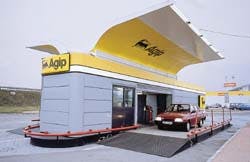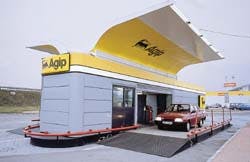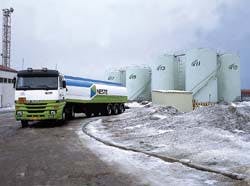European Retailers Scramble For Market Share In Former Communist Bloc
David Knott
Senior Editor
Agip has developed a portable filling station for delivering fuel to remote areas, a tactic to help it make inroads in the markets of formerly communist eastern Europe and the former Soviet Union (see related story, p. 36). (Photo courtesy of Minale, Tattersfield & Acton)
Neste Oy has built a retail chain in the former communist bloc nations covering the St. Petersburg area, the Baltic states, and Poland. The company is planning to consolidate operations here by opening a products import terminal at Riga, Latvia, from which fuel will be delivered by rail and road tankers. (Photo courtesy of Neste)A handful of western petroleum companies have been building up gasoline retailing operations in Europe's former communist countries, lured by the chance to pick prime sites to run high-throughput stations.
As the numerous markets opened up, existing retail networks were typically handed over to privatized state companies, while local independent retail firms, set up by local entrepreneurs, sprouted almost everywhere.
The first western companies to push into the new markets were Scandinavian firms, with their own refineries and a need to find new customers in the overcrowded European refining market: Finland's Neste Oy and Norway's Den norske stats oljeselskap AS (Statoil).
Then came the international giants. Royal Dutch/Shell has so far built the largest Eastern European retail operation of any western firm.
British Petroleum Co. plc and partner Mobil Corp. have established a strong position, and Exxon Corp. has built on long-established regional ties.
These remain the key western players in the new markets to date, but others are watching market developments with interest. Texaco Inc., for example, is believed to be considering developing a substantial retail chain in Poland.
Agip plans mobile gasoline stations for Russia
Italy's Agip has developed a novel concept to meet the unique market conditions of Russia's gasoline retailing sector: a mobile gasoline station.The station is designed to fit within standard 6 m x 9 m shipping containers and to be installed and in operation on a prepared site within 48 hr.
Marcello Minale, director of Minale, Tattersfield & Acton Ltd., London, which designed the mobile station, said two prototypes have been built and have completed trials in Prague.
Minale said the station has received approval for use in Russia and Eastern Europe. He reckons there could be great demand there.
"The stations can be built on order within 60 days," said Minale. "We reckon Moscow could need 200-400 units, while it would be ideal for remote areas because it generates its own power."
The stations have capacity to hold 25,000-40,000 l. of gasoline, which Minale said is enough to supply a small village for 3-6 months. He envisions the stations touring remote areas on a regular route.
Minale said the portable stations could also be used to keep conventional city sites operational during refurbishment and to provide fuel at major sports events and holiday spots.
Market drivers
Charbel Ackermann, Moscow-based vice-president of Boston Consulting Group, said the former communist bloc has a rapidly growing gasoline retail market driven by a booming car population (Table 1 [42241 bytes]).The total number of cars is growing at a rate of 4-5% a year, and within this the number of cars imported from Western Europe is growing at 20%/year. This provides an important spur to western retailers operating in Eastern Europe.
As an example, Ackermann cited 11 gasoline stations operated by Neste in the St. Petersburg area. The company bases its appeal to potential customers on quality.
For owners of western cars, Neste offers local specification A95 and A97 gasolines, which have a higher octane rating than conventional gasolines produced in Russia.
"The western car market is also important for BP," said Ackermann, "which is running a very large, nice station in Moscow. A large group of its customers are owners of foreign cars.
"This is an important market niche for high-quality gasoline and lubricants, but also the basis for BP's convenience store here offering a range of up-market goods including cognacs."
Indigenous suppliers are also catering to this growing niche sector. Imports of high-octane gasolines are available in all major cities, so western companies can obtain their retail supplies on the local market.
Russian vertically integrated companies such as Lukoil, Rosneft, and Yukos continue to dominate particular regions of Russia's retail market following the carve-up preceding privatization.
In the early 1990s, only 15% of Russia's total gasoline sales went to the retail markets. The bulk of fuel sold went to major fleet operators, typically owned by central government and local authorities.
Now 50% of gasoline sales are through retail outlets, which Ackermann cites as another tremendous dynamic behind retail sector growth.
"Most regions have a compound annual growth rate in retail station numbers of 20-35%," said Ackermann, "which means the number of gasoline stations could double every 2-3 years."
Scandinavian firms
Neste was the first western firm to open a retail station in Russia and the first in Estonia.The company has built a retail chain including the St. Petersburg area, the Baltic states, and Poland (Table 2 [75900 bytes]).
The company is planning to expand and currently has two new sites under construction in St. Petersburg. By 2000, Neste intends to expand in pace with the economies of these countries.
A Neste official said the company supplies some of its former communist-area stations with products from its Porvoo refinery, near Helsinki, with the rest coming from Russian refiners.
"We have a strong conviction that the range of distribution from our Porvoo refinery will decide our market," said the official. "This limits us to countries around the Baltic Sea."
Neste attracted a lot of attention from customers by being the first and still only foreign firm operating in St. Petersburg and by being first in Estonia. In the Baltic region, Statoil and Shell are now keen competitors.
"We have customers with western cars," said the official, "who want quality fuels and lubricants so they don't spoil their engines. We also have customers with eastern cars, and to these we sell local gasoline.
"A customer with a new car, though, will want to get the best fuels and services, and this has given a competitive edge to western companies."
Statoil, too, is basing its eastern European retail network on countries bordering the Baltic Sea. Again, closeness to the market of its refineries in Denmark and Norway was a key factor.
The Norwegian firm also chose the Baltic region because its infrastructure was underdeveloped. Neste and Statoil moved in quickly; Shell and others followed.
A Statoil official said, "The competition in our core area has hardened a lot recently, but we had tremendous sales in our introductory years."
The company sees the Baltic states and Poland as its main opportunities for expansion. Statoil also operates 50 stations in the former East Germany and is on the lookout for expansion there, too.
"Statoil's general philosophy," said the official, "is to get a fair share of a retail market at first, but not a dominant one. Then later we can grow to become market leader, as in Ireland."
Because of their wish to import from their own refineries, Neste and Statoil have leased a site jointly at the port of Riga, Latvia, to build a products import terminal.
The terminal is due to be on line in September or October and will ensure the two companies' networks along the Baltic Sea can be supplied with fuels more cheaply.
Both companies currently import gasoline and diesel fuel from their refineries via an import terminal at Tallinn, Estonia. From here, the fuels are transported by road tanker.
The new $40 million terminal will have storage tanks for the two companies, with a joint jetty, pipelines, and roads. There will also be road tanker loading facilities and a railway tank car depot.
BP, Mobil
At last count, BP had 10 stations in Poland and plans to open 35 more there by yearend; 9 in the Czech Republic, where the aim is to open 30; 22 in Hungary plus 4 sites together with Mobil; and 75 in eastern Germany.Harry Griffith, retail manager for the BP/Mobil alliance in Moscow, said that following the opening of a pilot retail station in Moscow last September, the company plans to open 10 new sites in the city this year.
The new sites will be large, with big convenience stores and car washes, while most will have fast-food restaurants alongside.
Griffith said Russian customers perceive BP's Moscow site as offering higher value products and greater convenience than Russian competitors.
"The pricing framework has been set to match the local market," said Griffith, "so we bring better service and prices than across the road at a container station.
"The shop offers a number of value items, with prices more attractive than almost all the western supermarkets in town."
Griffith said BP/Mobil's Russian network will be kept in Moscow, which offers a large opportunity in its own right. BP/Mobil aim to have 50-60 retail sites in Moscow within a few years.
"There are attractions outside Moscow, but our development philosophy is to focus on core markets before dispersing," said Griffith.
Exxon
Exxon organizes its Eastern Europe operations through its Esso AG unit in Hamburg.The company had lubricants operations throughout the region during the communist years and has long sold specialty chemicals there.
The company started its Eastern European retail network in Hungary, the country in that region that first opened its doors to western investors. Now Esso has 22 gasoline stations in Hungary, eight in the Czech Republic, three in Slovakia, seven in Poland, and 130 in former East Germany.
An Esso official said the company is looking to expand in the region's retail market but is not working toward fixed targets for station numbers because of what happened in East Germany.
"In East Germany," said the official, "everybody thought the total of 1,250 stations would grow to 3,500-4,000. After all, under the old regime, customers were often having to queue for 3-4 hr."
But these estimates, said the official, were based on figures provided by the companies, that were making assumptions according to the market share they were aiming at.
"All shot too high," said the Esso official. "Now there are only 2,200 stations in East Germany in total. Everybody has been building large stations, and now competition is very fierce there."
Esso is aiming to have 150 stations in East Germany, and has not set numbers for other countries: "We are aiming at economically feasible and sensible networks, but always a number greater than 20."
Amoco
One western company that has tested the waters of the formerly communist region's retailing, and quickly pulled out again is Amoco Corp.The company cites strategic refocusing as the reason.
An Amoco official explained that the company was pursuing business in Eastern Europe until last year and until 1995 had plans to develop retail networks in Bulgaria, Romania, and Poland.
Amoco had plans to build a pilot service station near Moscow, an offshoot of an abortive refining venture, which now will not be developed. The Romanian operation was sold to Hungarian state firm MOL Rt., while negotiations for sale of Polish and Bulgarian assets are said to be well advanced.
Local independents
In addition to western companies coming in, a swarm of local independent retailers has appeared, running typically as many as 20 stations in an area.While the long-established Russian and Eastern European firms have built a few new western-style stations-with underground gasoline storage tanks-to meet growing demand, the independents have mainly built "container" stations.
In container stations, the fuel is stored in containers aboveground. Licenses for container stations typically last 5 years, after which the operator is supposed to install tankage below ground.
Ackermann said there has been a 20% increase in the number of retail stations in all of Russia's main cities, and the new outlets are typically container stations.
While the container sites may be less costly to set up than underground storage sites, they often have a higher throughput than older conventional stations.
A Moscow container station would have a typical annual throughput of 8,000 metric tons/year, compared with the average Russian gasoline station throughput of 3,800 metric tons/year.
"Western companies are building western specification stations," said Ackermann. "A Neste station in St. Petersburg, for example, looks similar to a Neste station in Finland.
"Traditional Russian stations are in many ways not very attractive. They have no convenience stores or additional services and poor presentation of goods.
"Newer stations, even container stations, often look similar to western stations, in that the independents have installed stores and car wash units and are branding their products."
Some Russian independents have built large, attractive new stations without extra services and shops, seeing the profit on fuel sales alone as sufficient. Now vertical companies like Lukoil are building modern, western-style outlets.
Licenses
One of the problems facing newcomers to Eastern Europe's retail markets is delays in receiving licenses to operate.Ackermann said the processes need to be streamlined in most Russian cities, where license applications may take 18 months following land allocation.
Russia's bureaucracy is increasingly being streamlined, and there is still an issue of whether a "level playing field" exists in some areas regarding allocation of stations, but generally the authorities are increasingly looking to attract western investors.
"Neste in St. Petersburg has developed a process for dealing with licensing authorities," said Ackermann, "and has developed a relationship that is letting the company open stations at a much faster pace.
"It is the same with BP in Moscow. Now that the first station is open, it suggests the company now has the expertise to help it to the next step more quickly. BP's first station is in a very interesting location, from the point of view of passing traffic and the combination with a McDonald's restaurant on the same site."
BP and Mobil overcame the licensing problem by working in alliance with S&T Group, a Moscow-based real estate and property development company.
Griffith said: "It's a joint venture arrangement between BP/Mobil and S&T. S&T has lots of experience of land acquisition, seeking permits, and construction-a useful set of tools for our relationship."
BP started retail development in Russia before Mobil, and all BP/Mobil downstream operations in Eastern Europe are now carried out jointly following their European downstream merger. While BP was ahead in terms of time by 16 months, it was Mobil that introduced S&T to the venture.
The Esso official said the company's main operating difficulty has been in acquiring sites. Since governments have relinquished much land, it is very unclear who really owns what.
"You can pay for a site," said the Esso official, "and find another claimant turning up with interesting ownership papers. Or you can find another retailer coming along with a permit to build on the same site."
Esso is selective in its choice of sites, viewing location as the key to a station's economics. But the company is staying out of the former Soviet Union for now: "The retailing situation is still too unclear."
The Neste official echoed the view of the chief operating problem: "Our main problem has been that permit requirements and licensing authorities have been changing all the time.
"Also, it takes time to find out who is the real owner of land for new sites. This is nobody's fault, but land ownership legislation is not yet ready to clarify the situation."
Outlook
Ackermann said the outlook facing retail companies is different for the three main types of firms: vertically integrated companies, independents, and western firms.When the Russian retail network was privatized, existing networks were carved up among integrated firms, which were given dominance in their operating areas.
The former state firms have invested less in new retail stations than new independents in many areas, but Lukoil in particular has begun to invest to protect market share in core regions.
By installing container stations, independents have made a return on their investments after only 2 years, but with the licenses due to run out in 2-3 years typically, they will need to reinvest in underground storage.
So integrated companies are likely to begin branding their networks and products more strongly, while independents are expected to develop their marketing and service skills to keep them competitive.
"Integrated companies need to make strategic decisions," said Ackermann, "about how much growth they want from their own stations, which are their core stations, and which they want to operate or license.
"Then they must decide the size of their investment, because spending will be required to grow with the market. For example, it costs $500,000-1 million to build a new station in Russia, and Lukoil plans to build 300-500 new stations over the next few years."
Ackermann sees Shell, Neste, and BP/Mobil as the players most keenly looking for expansion in the former communist bloc.
Neste is expected to have more than 15 stations in the St. Petersburg area by yearend, while Shell is said to be interested in most countries in the region and looking to establish itself in Russian retailing.
"There is a perception among western companies that they can make good profits running stations according to western standards in the former communist bloc," said Ackermann.
"That way they can achieve typical throughputs of 5,000-7,000 metric tons/year of gasoline. Emerging markets are very attractive to western firms, because they can acquire attractive new locations to achieve good profits."
Copyright 1997 Oil & Gas Journal. All Rights Reserved.


